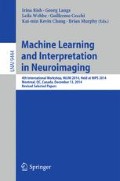Abstract
This paper introduces a framework for analyzing longitudinal neuroimaging datasets. We address the problem of detecting subtle, short-term changes in neural structure that are indicative of cognitive decline and correlate with risk factors for Alzheimer’s disease. Previous approaches have focused on separating populations with different risk factors based on gross changes, such as decreasing gray matter volume. In contrast, we introduce a new spatially-sensitive kernel that allows us to characterize individuals, as opposed to populations. We use this for both classification and regression, e.g., to predict changes in a subject’s cognitive test scores from neuroimaging data alone. In doing so, this paper presents the first evidence demonstrating that very small changes in white matter structure over a two year period can predict change in cognitive function in healthy adults.
M.H. Coen and M. Hidayath Ansari—Contributed equally to this work.
Access this chapter
Tax calculation will be finalised at checkout
Purchases are for personal use only
References
Alzheimer’s disease neuroimaging initiative (ADNI). http://www.adni-info.org
Bowley, M.P., Cabral, H., Rosene, D.L., Peters, A.: Age changes in myelinated nerve fibers of the cingulate bundle and corpus callosum in the rhesus monkey. J. Comp. Neurol. 518(15), 3046–3064 (2010)
Dyrba, M., et al.: Combining DTI and MRI for the automated detection of Alzheimer’s disease using a large european multicenter dataset. In: Yap, P.-T., Liu, T., Shen, D., Westin, C.-F., Shen, L. (eds.) MBIA 2012. LNCS, vol. 7509, pp. 18–28. Springer, Heidelberg (2012)
Friedman, J., Hastie, T., Tibshirani, R.: Regularization paths for generalized linear models via coordinate descent. J. Stat. Soft. 33(1), 1 (2010)
Gretton, A., Fukumizu, K., Sriperumbudur, B.K., et al.: A fast, consistent kernel two-sample test. In: Advances in Neural Information Processing Systems, pp. 673–681 (2009)
Grydeland, H., Westlye, L.T., Walhovd, K.B., Fjell, A.M.: Improved prediction of Alzheimer’s disease with longitudinal white matter/gray matter contrast changes. Hum. Brain Mapp. (2012)
Le Bihan, D., Mangin, J.-F., Poupon, C., Clark, C.A., Pappata, S., Molko, N., Chabriat, H.: Diffusion tensor imaging: concepts and applications. J. Magn. Reson. Imaging 13(4), 534–546 (2001)
Misra, C., Fan, Y., Davatzikos, C.: Baseline and longitudinal patterns of brain atrophy in mci patients, and their use in prediction of short-term conversion to AD: results from adni. Neuroimage 44(4), 1415 (2009)
Rahimi, A., Recht, B.: Random features for large-scale kernel machines. Adv. Neural Inf. Process. Syst. 20, 1177–1184 (2007)
Raman, P., Phillips, J.M., Venkatasubramanian, S.: Spatially-aware comparison and consensus for clusterings. In: Proceedings of SIAM International Conference on Data Mining (SDM) (2011)
Reitan, R.M., Wolfson, D.: The halstead-reitan neuropsychological test battery for adults: theoretical, methodological, and validational bases. In: Neuropsychological Assessment of Neuropsychiatric and Neuromedical Disorders, p. 1 (2009)
Sager, M.A., Hermann, B., La Rue, A.: Middle-aged children of persons with alzheimer’s disease: APOE genotypes and cognitive function in the wisconsin registry for alzheimer’s prevention. J. Geriatr. Psychiatry Neurol. 18(4), 245–249 (2005)
Smith, S.M., Zhang, Y., Jenkinson, M., Chen, J., Matthews, P.M., Federico, A., De Stefano, N., et al.: Accurate, robust, and automated longitudinal and cross-sectional brain change analysis. Neuroimage 17(1), 479–489 (2002)
Trenerry, M.R., Crosson, B., DeBoe, J., Leber, W.R.: Stroop Neuropsychological Screening Test Manual. Psychological Assessment Resources, Odessa (1989)
Ziegler, D.A., Piguet, O., Salat, D.H., Prince, K., Connally, E., Corkin, S.: Cognition in healthy aging is related to regional white matter integrity, but not cortical thickness. In: Neurobiology of Aging, vol. 31, pp. 1912–1926. Elsevier, November 2010
Author information
Authors and Affiliations
Corresponding author
Editor information
Editors and Affiliations
Rights and permissions
Copyright information
© 2016 Springer International Publishing AG
About this paper
Cite this paper
Coen, M.H., Hidayath Ansari, M., Bendlin, B.B. (2016). Predicting Short-Term Cognitive Change from Longitudinal Neuroimaging Analysis. In: Rish, I., Langs, G., Wehbe, L., Cecchi, G., Chang, Km., Murphy, B. (eds) Machine Learning and Interpretation in Neuroimaging. MLINI MLINI 2013 2014. Lecture Notes in Computer Science(), vol 9444. Springer, Cham. https://doi.org/10.1007/978-3-319-45174-9_11
Download citation
DOI: https://doi.org/10.1007/978-3-319-45174-9_11
Published:
Publisher Name: Springer, Cham
Print ISBN: 978-3-319-45173-2
Online ISBN: 978-3-319-45174-9
eBook Packages: Computer ScienceComputer Science (R0)

